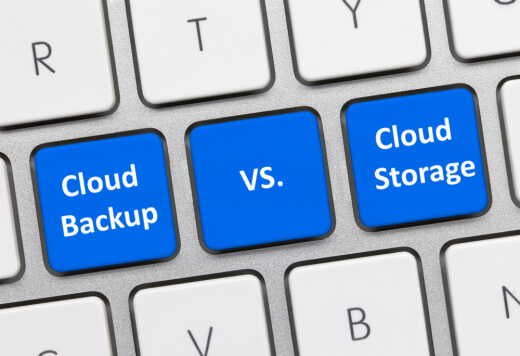No doubt, all the batting around of cloud-related terms has clouded things. It leaves many people confused about what the cloud is and what the different cloud terms mean. And that includes cloud backup and cloud storage. People use these terms interchangeably but they’re not the same.

Understanding the difference between cloud storage and cloud backup will help you decide what you need.
What Is the Cloud?
The cloud sounds like something that floats all around us. In reality, the cloud is where data and programs are stored over the Internet. The data stored in the cloud actually lives on computers somewhere where a server can process requests and deliver data from one computer to another.
For instance, you could use a computer in Texas but your files live on a computer somewhere in Boston. If you travel from Texas to California, you’ll still be able to access those files in Boston.
The cloud makes it possible to back up and store files from anywhere and on any device. The cloud is everywhere. It means you can see your files from wherever you are as long as you’re logged in to your cloud storage space.
If you’re working on a desktop computer at home and save your file to your computer’s hard drive, it’s called local storage. You can’t access that file in Boston or California. The only way to access it is if you take your computer with you.
On the other hand, if you’re working on a desktop computer at home and save the file to your cloud storage, you’ll be able to access that file from anywhere when you log into your cloud account. You don’t have to lug your desktop with you. Your connected phone, laptop, and tablet can access the files in your file storage account.
However, if you cannot connect to the Internet via a network or Wi-Fi, you won’t be able to access your files in the cloud.
What Is Cloud Backup?
Cloud backup means you save all your data to the cloud. Many people use a cloud backup service to back up their data in the cloud. This allows them to access it from anywhere. And if their computer stops working, they still have their files in the cloud.
In addition to having everywhere-access to their data, it also protects them from data loss. Every time a file changes or the user creates a new file, it’s backed up to the cloud.
In short, cloud backup is online backup. And it replicates all the data on your local computer or device. If a laptop that uses cloud backup gets stolen, its data is still available in the cloud.
After working past the frustration of losing the laptop, the owner buys a new laptop. As soon as the laptop is connected to the Internet, the owner can restore the cloud backup to the new computer. Cloud backup services restore everything including your file system structure.
Many online backup services exist. They offer different options. Most backup on a regular basis. The timing of the backup may vary. It can be continuous, once a day, once a week, or some other option.
They may have a limitation on how many devices you can backup and the amount of data the service will back up. Online backup services also vary on pricing, security, upload speeds, interface performance, interface usability, and restore settings.
The downside of cloud backup is that it only works if there’s an internet connection. And even with an Internet connection, restoring data can take a long time. This is especially true in a corporate environment that requires restoring data across many computers.
What Is Cloud Storage?
Cloud storage is simply storage in the cloud. Instead of storing a file on your local computer or device, you save it elsewhere. Like cloud backup, cloud storage allows you to keep your files in the cloud managed by a third-party provider. Popular cloud storage services include Dropbox, Google Drive, Apple iCloud, and OneDrive.
You can access the files you save to cloud storage from anywhere. You can also easily collaborate with friends and colleagues by giving them access to the files. Typically, the file owner can control the type of access others have, which could be read-only or editing. People like storage services because it lets them work on files from any device in any location. It can store photos, videos, documents, spreadsheets, and any other files you need to access wherever you go.
With cloud storage, you select the files or folders that you want to save in the cloud. It’s typically a manual process to select and store your files. It’s possible to set up automatic file sync and run backups at the file and folder level. If a computer crashes and experiences data loss, file storage will not recover all the data. The only recoverable data is whatever files you transferred to online file storage.
Some people use cloud storage to supplement their local hard drives. Some people use it to keep current and important files both locally and in the cloud. Some people use it for files they need to share with others.
Cloud Backup vs. Cloud Storage
It’s possible you may need to use both cloud backup and cloud storage. It’s wise to backup all your data to someplace other than your local hard drive. That way, if anything happens to it, you still have your data in a safe place.
With cloud storage, you don’t have to email files to people for collaboration. You can upload it to cloud storage and share it.